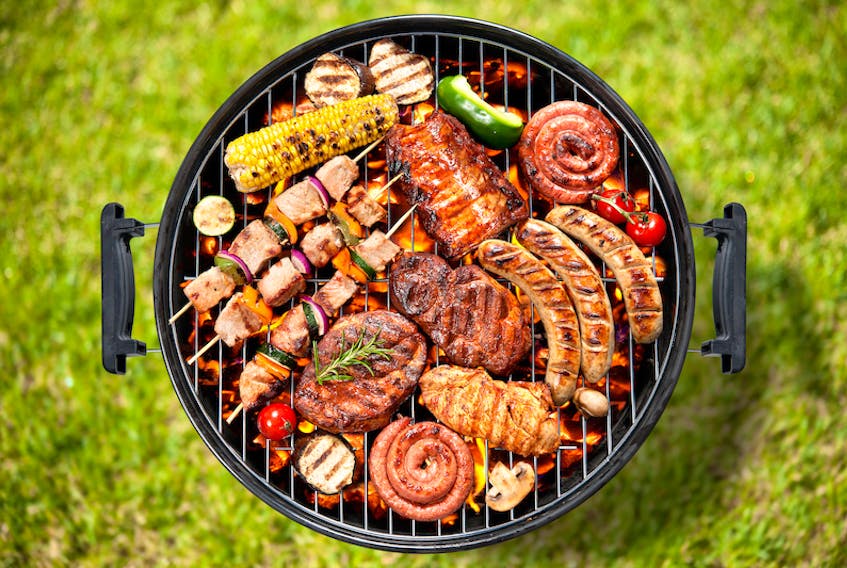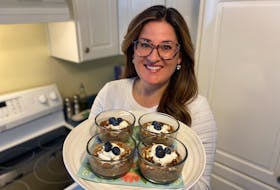Summer heat waves don’t often last for extended periods in P.E.I., and many of us live in homes without air conditioning. I sometimes find myself unprepared when, like last week, we experience a run of hot days.
How can we alter the ways we prepare meals in ways that keep the house as cool as possible and still eat well?
It’s helpful to have some dishes or meals at the ready so that you can stay cool on hot days. If you have a freezer, you have an advantage. On a cool day, cook extra meat, chicken or beans to freeze and add to salads, stir-fries, sandwiches or wraps or divide leftover casserole into single servings for the freezer, ready to pull out and reheat when cooking a full meal is not the preferred option.
Changing the timing is another strategy. The time to cook oven meals or fill the stovetop with bubbling pots is when temperatures are cooler. That’s one of the advantages of the traditional farmhouse practice of serving dinner at noon and a lighter meal, supper, later in the day. The house is still relatively cool in the morning when you’re in the kitchen preparing the largest meal of the day. Drawbacks are that cooking, even in the morning, adds heat to the kitchen and this timing does not work for people who leave their home to go to work all day.
Changing where you cook is also a strategy, the most obvious one, for keeping your living quarters as cool as possible. Whether you barbecue succulent smoky ribs all day over slow charcoal heat or quickly cook vegetables and chops on a propane grill, a hot day is a fine time for outdoor cooking.
Changing the cooking method is another strategy. A quick cooking stir-fry generates less heat in the kitchen than does an oven meal. Small appliances are particularly useful when temperatures are hot. You create less ambient heat when cooking a meal in a slow cooker or an electric multicooker than you would if cooking a similar dish in the oven or on the stovetop.
If you have kale or spinach growing in the garden, use them in this healthy, economical plant-based meal. Look for dried kidney beans and the spices and herbs at the bulk food store. I have made this recipe using reduced sodium beef broth instead of the vegetable stock; it does, however, lose its status as a vegetarian dish with this change. Feel free to omit the salt in this recipe, especially if using stock containing salt.
Use a small (1½ to 3 quart) slow cooker if halving the recipe.
Red Beans and Greens
Adapted from Finlayson, Judith: The Healthy Slow Cooker, Second Edition, Robert Rose Inc., Toronto, 2014.
Use a medium to large (3½ to 5 quart) slow cooker.
500 mL (2 cups) dried kidney beans
15 mL (1 tbsp) olive oil
2 large onions, finely chopped
2 stalks celery, finely chopped
4 cloves garlic, minced
5 mL (1 tsp) dried oregano
5 mL (1 tsp) dried thyme
2 mL (½ tsp) salt
2 mL (½ tsp) cracked black peppercorns
1 mL (¼ tsp) ground allspice or 6 whole allspice, tied in a piece of
cheesecloth
2 bay leaves
1 L (4 cups) vegetable stock
5 mL (1 tsp) smoked paprika (optional)
Greens
1 kg (2 lb) greens, thoroughly washed, stems removed and
chopped
butter or butter substitute
15 mL (1 tbsp) balsamic vinegar
salt and freshly ground black pepper
Soak beans in about 1.5 L (6 cups) cold water overnight. Drain, rinse and set aside.
In a skillet, heat oil over medium heat. Add onions and celery and cook, stirring, until softened, about 5 minutes. Add garlic, oregano, thyme, salt, peppercorns, allspice and bay leaves and cook, stirring, for 1 minute. Transfer to slow cooker stoneware. Add beans and vegetable stock.
Cover and cook on low for 8 to 10 hours or on high for 4 to 5 hours, until beans are tender. Stir in smoked paprika, if using.
Greens: Steam greens until tender. Toss with butter or butter substitute and balsamic vinegar. Season with salt and pepper to taste. Add to beans and stir to combine. Serve immediately.
Makes 6 to 8 servings.
Margaret Prouse, a home economist, writes this column for The Guardian every Friday. She can be reached by email at islandgusto@gmail.com.









